Indian philosopher and mystic Bhagwan Shree Rajneesh had a vision: he would build a Utopian city from the ground up, starting with 64,000 acres of muddy ranchland in rural Oregon.
Purchased in 1981, this expanse was to become both a fully-functional urban center and a spiritual mecca for his followers from around the world.
For this plan to work Rajneesh and his red-clad devotees (known as “sannyasins”) needed autonomous authority with which to construct their paradise.
Circumventing local land use restrictions was not a problem so long as their city of Rajneeshpuram was incorporated, which would allow them to issue their own building permits. Fortunately for them, the main requirement for incorporation at the time was a population of 150 people, which they met easily by importing more followers.
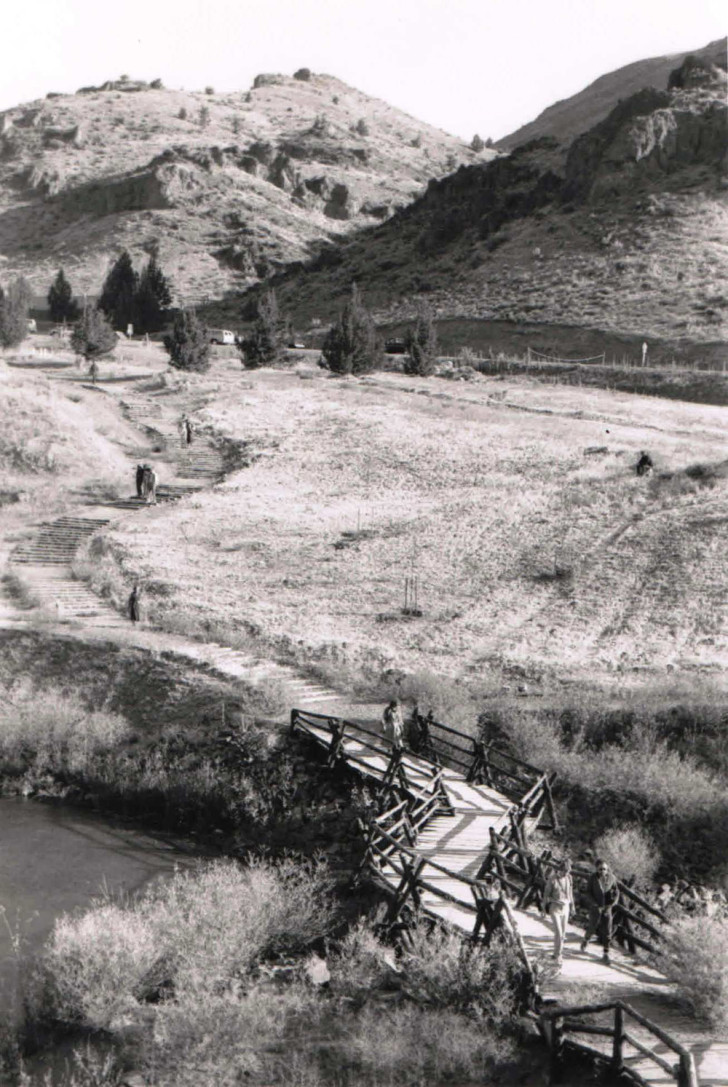
Funding flowed in to support construction from a global network of lucrative communes, as well as sannyasins who sold their earthly possessions and donated the proceeds toward the effort. These devotees were also taught that labor was a form of meditation, and willingly worked long hours to make Rajneeshpuram a reality.

With devoted laborers working to dam water, build power infrastructure, and construct buildings, a city quickly began to sprout from the soil.
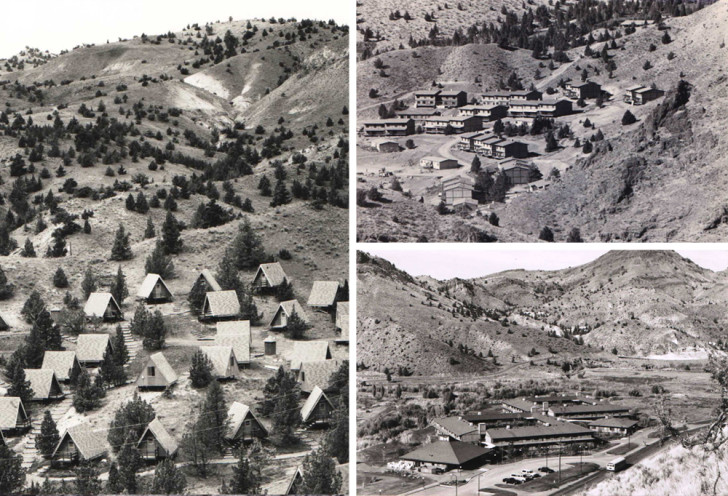
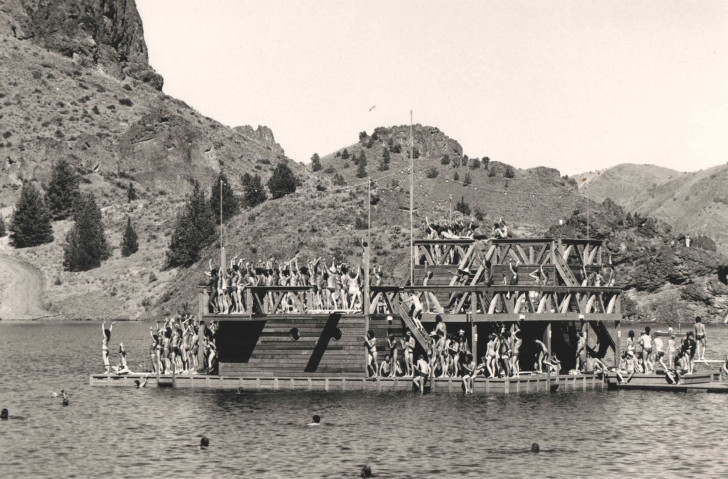
They built a strip mall, a hotel, a discotheque, meditation center, post office, air strip, power station, recreation structures, and more.
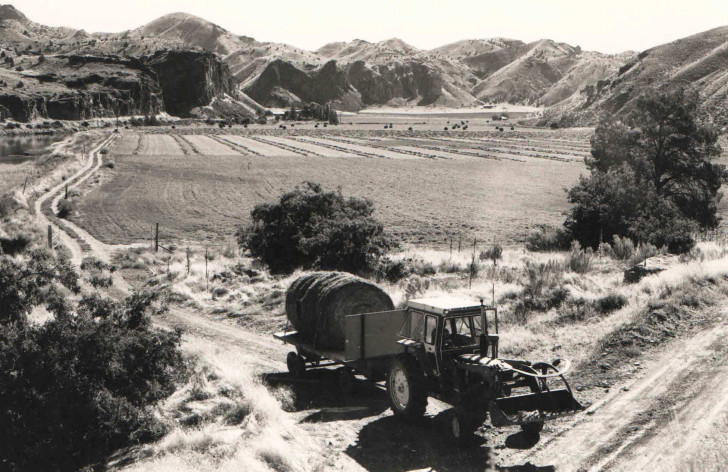
Carefully cultivated farmland provided organic food sufficient to support the local population.
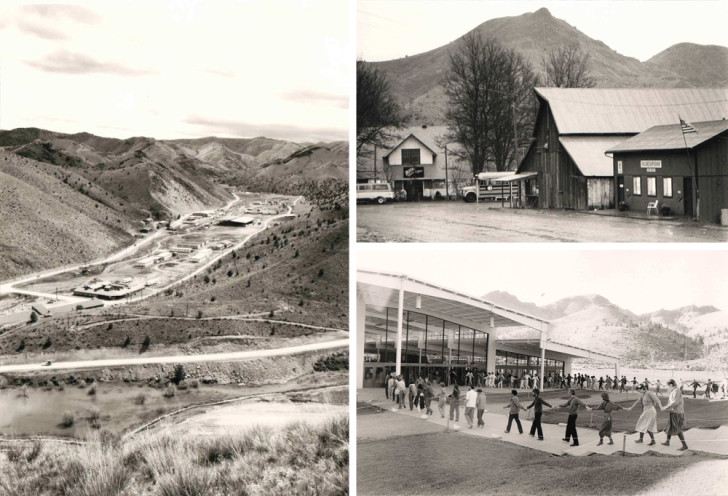
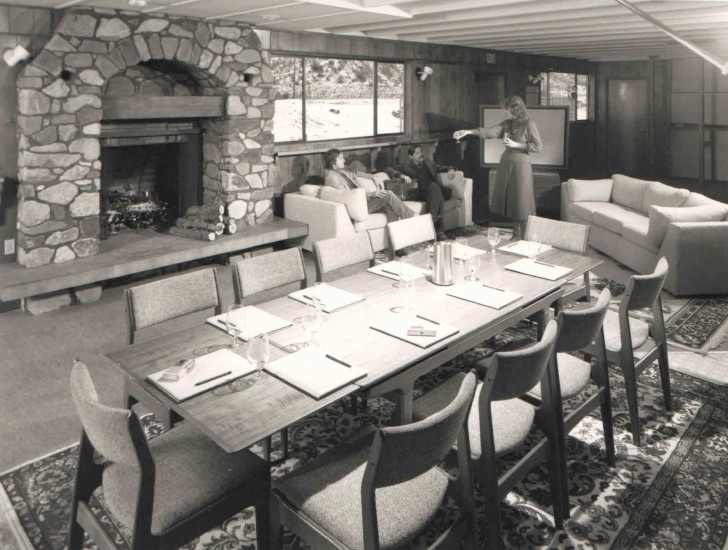
Within a few years, the population jumped from hundreds to thousands and the city expanded to absorb newcomers. A mass transit system comprised of 85 school buses crisscrossed their modest new metropolis.
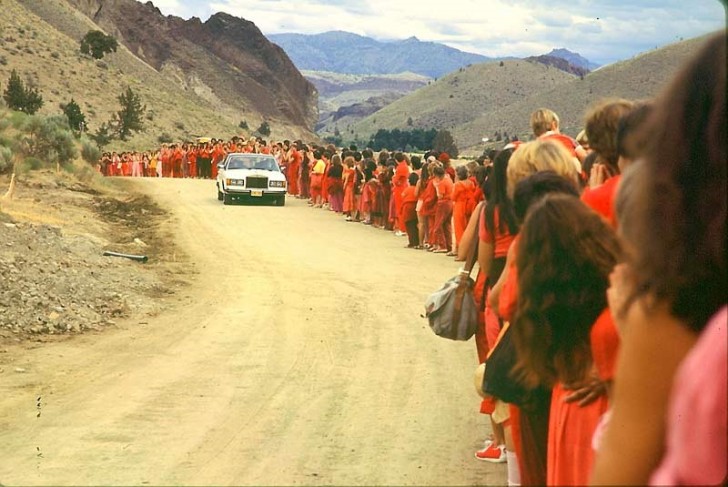
Bhagwan Shree Rajneesh himself, however, preferred to get around by car. He cruised the streets every day in one of his ninety-three Rolls Royces.
Having taken a vow of silence, he delegated the everyday operations of the city to a matriarchal council. His primary spokesperson was Ma Ananda Sheela, a woman who took on increasing amounts of authority.
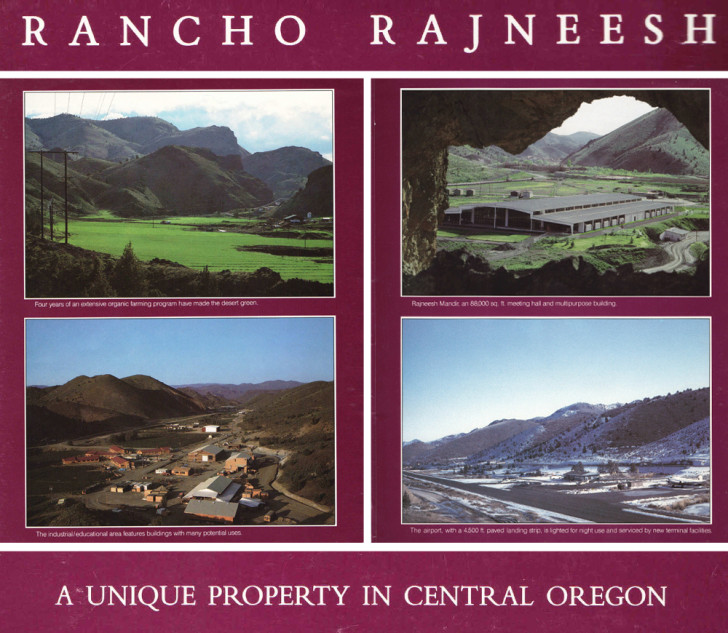
While nearby communities and environmentalists had concerns about Rajneeshpuram throughout its evolution, those worries grew as the Rajneeshee began to harass the neighboring town of Antelope. Various intimidation tactics were employed in an attempt to take over the Antelope city council. The Rajneeshee were ultimately successful, and the town of Antelope was renamed Rajneesh.

Responding to threats real or perceived, Rajneeshpuram authorities formed a police force—called the “Peace Force”—and began stockpiling weapons. The city even had two helicopter reconnaissance teams.
This escalation caused further concern and led state and county officials to stall construction in Rajneeshpuram and call the legality of its existence into question.
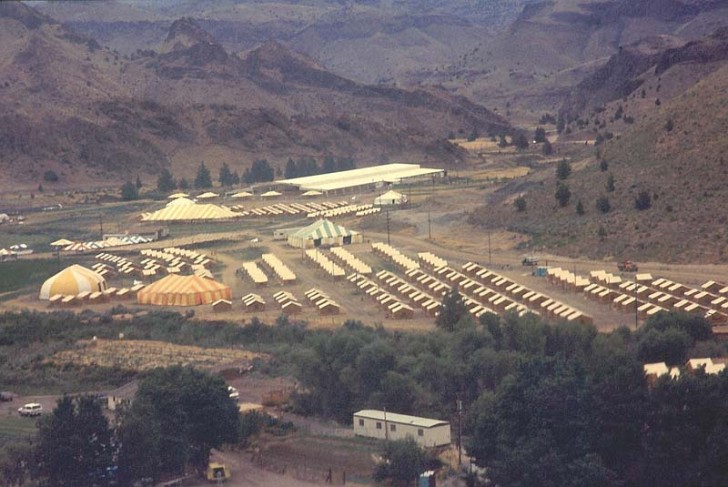
Rajneeshpuram responded with more growth. Through a program they called “Share-A-Home,” Rajneeshpuram began to bus in thousands of homeless people from around the country, offering them places to live. They also encouraged them to vote in local elections. It would later come out that these new residents were drugged with a powerful antipsychotic called Haldol. Many such recruits left soon after they arrived.
In an even more desperate bid to block locals from voting a group of sannyasins poisoned a local salad bar with salmonella. No one died but 750 people became sick. To this day the attack remains the largest act of bioterrorism on US soil. To this day the attack remains one of the largest act of bioterrorism on U.S. soil (see addendum).
Investigations began to unravel the city, one allegation at a time. Multiple attempted murders, forced sterilizations and the firebombing of the Wasco County Planning Department were tied to Rajneeshpuram. As new facts and accusations came to light, Sheela vanished and Rajneesh came forward in an attempt to deescalate tensions.
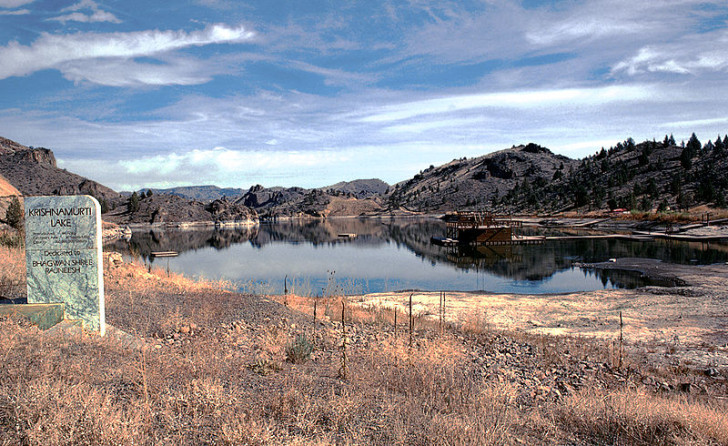
These efforts came too late. Rajneeshpuram was in a downward spiral, its disillusioned devotees leaving in droves.
Sheela fled and was tracked to West Germany then extradited to the United States and pled guilty to a series of serious charges. Today she lives in Switzerland and runs a series of nursing homes for the elderly and disabled.
Rajneesh was convicted of more minor offenses, was fined, put on probation and deported.
He returned to India and continued as a spiritual leader under the name Osho, dying less than a decade later of natural causes.
Rajneeshpuram was dissolved and its valuables auctioned off, including its founder’s collection of luxury cars. Its land and buildings now fall under county jurisdiction.

The meditation hall is now a sports complex and the old hotel a dormitory, all serving Young Life, a Christian teen camp. It remains a place for religious seekers, just not the kind who want to build a Utopia on Earth.
![Advertisement for "Rajneesh Busters" t-shirts, circa 1981-1985, In Religion collection [manuscript], Mss 1517](https://99percentinvisible.org/app/uploads/2015/10/rajneesh-600x934.jpg)
Correction: The radio story says that the Rajneeshee poisoning of a nearby salad bar was the largest act of bioterrorism committed on U.S. soil; the largest acts of bioterrorism were the intentional transmissions of infectious disease by early American colonists to Native Americans, as with William Trent’s gifting of smallpox-laced blankets to two Native American chiefs visiting Fort Pitt in 1763. We regret the error.
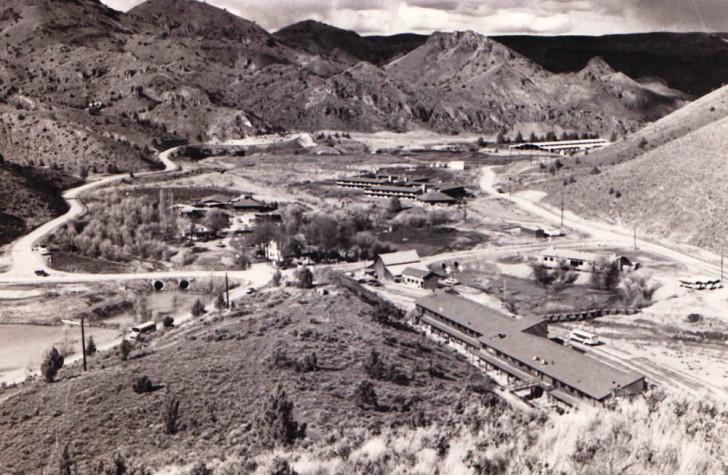




Comments (33)
Share
Totally still listening!
Very interesting episode. My grandparents and some family friends were some of the victims of the salmonella poisoning in a restaurant in the city of The Dalles.
A lot of spiritual people still quote and revere Osho with no idea about this story.
Great episode, shows the ways we can go around existing policies to create, in this case a small city that didn’t have a good end to it. What is the song midway of the podcast?
What perfect symmetry that it’s now a Young Life site. Some things never change, they just get shined up for the next batch of willing sycophants.
Thank you
Gotta love Jesus. F young life.
jesus has a way of taking something dead, degraded or decayed and bringing it back to life. Cleansing, salvaging and healing it for vibrant new life. The people in the pic are having something called FUN. without plotting to murder or enrich some decadent old phoney. You have NO clue.
Always Read the Plaque: http://readtheplaque.com/plaque/antelope-or
We toil in the fields and he drives around in a Rolls-Royce?
It always comes down to that doesn’t it, with commune leaders or dictators.
Matt Groening used this guy and his organization/cult into an episode of The Simpsons called The Joy of Sect when the Simpson family falls under the spell of a charismatic leader who drives around in a Rolls Royce like this guy.
Great episode. I grew up in Portland during this time and heard about this as it unfolded on the radio news, but I was a kid and it’s nice to revisit what happened. In addition to those memories, this episode reminded me a of “The Mega Maharishi”–a local wrestler in the “heel” role who would don the red robes of Rajneeshpuram and rile up the crowd in the 80s:
There was also this song on a local Portland radio station’s morning show, https://www.youtube.com/watch?v=5q6A7swQjIk I was was too young back then to really know what was going on, but it was great to hear this episode.
For the first few moments into the episode, I thought that Roman and his team decided to take a tune from Rahman to start the episode. The link https://www.youtube.com/watch?v=gg551NGy7MI&feature=youtu.be&t=37s will start at just the right spot revealing the original source of Humeysha’s “”inspiration””.
That was my attempt at a two handed air quote, twice. ;) Enjoy!
Enjoy!
BBC Witness also did a piece about Rajneeshpuram recently–their guest talks a little more about the “no disagreement” policies of the group: http://www.bbc.co.uk/programmes/p02yy64n
This episode was so fascinating to me, especially since I had just submitted a proposal for some potential work in the neighboring Sherman County. Going to be visiting this area tomorrow and hopefully more in the future.
who provides the music besides humeysha for this episode?
What was the song that was mentioned at the end of the podcast I can’t find it anywhere, or maybe I keep misspelling it?
It’s “For Love, From The Law”
Fascinating piece! Congratulations!
I first arrived at Rajneeshpuram in August of 1984, shortly before the Share a Home program began. I was there for about three months in the fall of ’84. My last time at Rancho Rajneesh was October 1985, after Bhagwan’s middle-of-the-night attempted escape that landed him in a North Carolina jail wearing an orange jumpsuit (surprised you didn’t mention that) and shortly before it was all dissolved.
Your account is fairly balanced, but like so many in the media, you focus on the big news story and mostly miss what this movement was really about. No, building a utopia wasn’t the big goal of the group. That was just another stop along the way.
Yes, some of the people who had been around longer than I put their hearts and souls into it and were disappointed to see it all fall apart. But a popular joke among sanyassins was about someone who falls off a building and halfway to the ground says, “So far, so good.”
It was about being spontaneous, overcoming the things that hold us back, and accepting life. As you mentioned, Bhagwan took ideas from all the religions as well as modern psychology and turned them into his own teachings. I benefited greatly from my time as a sanyassin. And I didn’t have to give up all of my personal belongings. Maybe some did that, but almost everyone I knew still had their stuff and their lives.
I knew nothing about what was really going on with Sheela and her cronies, but most of us knew that things weren’t right at the top.
Also, your story makes it sound like all or most of the homeless people brought in were drugged, but that was not what I saw. I worked with many of them on the farm and ate with them in the dining rooms. For some of them, their time at the ranch was a life-changing experience.
Thanks for letting me relive those magical days a little bit with your mostly well done story. And thanks for posting the photos here. I still have my Rajneesh Currency Card, too.
If you want to do a followup story on life at the ranch among those of us who weren’t involved in the criminal activity at the top, let me know. I’d be happy to share my perspective.
Weird that you didn’t discuss that Young Life is either a cult, or right on the edge of being a cult. Your story made it sound like an innocent summer camp, when we all know it’s reputation is very different than that. I’m here for the often invisible truth, and don’t think it wise to gloss over the controversy surrounding this group. You don’t have to agree with it, but it at least is worth noting.
This cult camp was described by Christopher Hitchens in his book “God is Not Great – How Religion Poisons Everything”. It’s sad that ownership of the camp just seems to have been passed from one small cult to a much larger one. Couldn’t it just be a nice vacation resort?
From Young Life’s Wikpedia page:
<>
This may be overly picky, but while it is certainly important to recognize the genocide and war crimes committed by European colonizers of the Americas, I think the addendum is not technically accurate. In 1763, the US did not exist, so it was on US soil. Again, certainly worth noting, and something that we do far to little in the US (especially compared Canada), so thank you for recognizing it, but perhaps it would be more accurate to say in North America…
Not on US soil*
Great feature and very well done. Minor point: the mass poisoning (Salmonella typhimurium) was the largest known bioterrorist attack on US soil. The intent behind the smallpox blankets was truly horrific but there’s no evidence that it hastened the spread of the disease: most indigenous populations had already died or had been exposed via natural transmission. The smallpox lesions (crusts) would not have carried active virus.
Thank you. Invoking smallpox blanket legend does not lend credence to this article.
A few years on, the conversation regarding the mechanisms of isolation and abuse has opened and broadened. I’m just a casual observer of movements like this, but having enjoyed this episode and having followed the conversations around abuse, I’d be keen to hear a follow-up episode that addresses the spatiality of cult dynamics and abuse within this community.
https://newrepublic.com/article/147657/outside-limits-human-imagination
I loved this episode and am delighted for an even further deep dive with the Duplass Brothers’ new series on Netflix:
https://www.rollingstone.com/culture/features/wild-wild-country-is-netflix-doc-subject-really-a-sex-cult-w518919
You said Osho died of natural causes, however he himself the one who died says that he was poisoned by the U.S Goverment, during his 12 day, no bail, jail time in 6 different jails. Look up the video on Youtube. There was little to no evidence of Baghwans involvement in the crimes he was charged with. Think about it, even if he did do crimes there would be no evidence against him. He didn’t take part it any crimes and communicated very discreetly, infact he was in complete silence for several years. They kept him in 6 different jails for 12 days without bail and evidence. He took the deal so that he could have peace. He was tired and chose not to fight the case, which according to several expert lawyers, he had a good chance of winning…..The fact that you have a whole article on him, means that he did something. Look into his teachings not the stories and press, read his books. He literally tells evryone to listen to no one including OSHO. Many of the experiences of actual people living there went under the radar. Look it up. Wild Wild West needs to get numbers up.
Osho was charged with arranging marriages, which were bogus charges – and his lawyers were told that but warned that they’d keep him in jail and drag the trial on for years. He made an Alfred Plea, in which he agreed not to return to the US for 5 years. There were absolutely arranged marriages – but not by Osho. We all wanted to live there. It was paradise. We worked hard, played joyously, ate like royalty, and sang and danced our hearts out. It took a lot of money to build that world – so those who had money happily offered it.
The Reagan administration managed to keep him from settling in many countries that loved him, particularly Uruguay, by threatening to call in their debt. Eventually, he returned to India where the ashram has thrived for many years.
I highly recommennd watching the documentary “Wild wild country” on netflix. Fascinating!